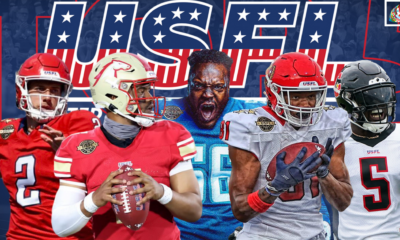
American football has always been a popular sport in the United States, but thanks to technology, it has broken down barriers and reached a wider audience than ever before.
This article will explore how American Football has built a community of sports enthusiasts by leveraging digital platforms, expanding reach through social media and innovating the viewing experience – and everything else that has helped them cultivate a global fan base.
Building a Community
The US Football League has done an incredible job of bringing together a passionate community of sports enthusiasts. They’ve gone above and beyond to create a platform where fans can connect, share their love for the sport and feel a sense of belonging. From fan events to meetups, supporters can gather to watch games, discuss strategies and cheer for their favorite teams creating an environment where the energy is electric and the camaraderie is contagious.
But the league’s efforts don’t stop there as they’ve also focused on grassroots initiatives to involve local communities. By organizing youth programs, coaching clinics and community outreach events, they’re promoting the sport at a grassroots level. It’s a smart move that not only invests in the development of young talent but also nurtures a new generation of sports enthusiasts.
And let’s not forget about online sports betting. The US Football League has embraced this trend to further build its community of sports enthusiasts. Online sports betting platforms are a space where fans can come together to discuss and analyze games, share predictions, place bets and learn more about this process and their favorite teams. However, keep in mind that it’s crucial to this type of entertainment responsibly and within the legal framework set by the respective authorities.
Social Media
Technology has played a significant role in helping the US football league connect with a larger audience by expanding its reach through social media, with platforms such as Facebook, Twitter, Instagram and YouTube providing the league with powerful tools to engage with fans and promote their content. These platforms allow the league to share real-time updates, highlights and behind-the-scenes content with fans which has helped create a sense of excitement and connection among them, even if they are not physically present at the games.
Fans can now follow their favorite teams and players, stay updated on match results and engage in discussions with other fans – all through social media.
Social media platforms have enabled the league to target specific demographics and reach a wider audience. Through targeted advertising and content promotion, the league can tailor its messages to reach fans who may not have been previously exposed to football. This has helped in attracting new fans and expanding the league’s overall reach.
These platforms provide a space for fans to interact with each other and with the league itself as they can share their thoughts, opinions and experiences, creating a sense of community and fostering engagement. The league can also directly interact with fans by responding to comments, addressing concerns, and even conducting live Q&A sessions.
This level of interaction helps to build a stronger connection between the league and its audience. Furthermore, social media platforms offer opportunities for fan-generated content. Fans can create and share their own videos, photos, and stories related to the league, further amplifying the reach and impact of the league’s message. This user-generated content not only increases engagement but also serves as a form of free promotion for the league.
Reimagining the Viewing Experience
Technology has revolutionized the way we experience football in the US, connecting fans with the game like never before. Thanks to advancements in streaming services and online platforms, football enthusiasts can now access live games and highlights from anywhere, at any time. No more waiting for cable or satellite subscriptions to catch the action – the sport is now more accessible to a wider audience than ever before.
Online platforms have also introduced interactive features like live chat, social media integration and real-time statistics which truly take the viewing experience to a whole new level as fans can now engage with each other and the game in exciting new ways, making football more than just a spectator sport.
And let’s not forget about virtual and augmented reality technologies. With VR headsets, viewers can transport themselves to the stadium and experience the game in a 360-degree immersive environment – it’s like being right in the middle of the action, even if you’re watching from the comfort of your own home. AR technology, on the other hand, can overlay graphics and information onto the live broadcast, providing viewers with additional insights and analysis.
Thanks to technology, football in the US has become more than just a game, growing as an immersive, interactive experience that connects fans with the sport they love.
Mobile Apps
Technology has played a significant role in helping the US football league connect with a larger audience and enhance fan engagement through mobile apps. With the rise of smartphones and the increasing accessibility of mobile devices, football leagues have recognized the importance of utilizing technology to reach and engage with fans. Mobile apps have become a powerful tool for football leagues to connect with their audience in real time. These apps provide fans with instant access to live scores, game highlights, player statistics and news updates. This allows fans to stay connected and engaged with their favorite teams and players – even if they are unable to attend the games in person.
Furthermore, mobile apps have also facilitated interactive experiences for fans. Features such as live streaming of games, interactive polls and social media integration allow fans to actively participate and share their experiences with others. This not only enhances fan engagement but also creates a sense of community among football enthusiasts.
Mobile apps have also opened up new avenues for revenue generation for football leagues. Through in-app purchases, ticket sales, merchandise sales and advertising opportunities, leagues can monetize their mobile apps while providing added value to fans. Moreover, technology has enabled personalized experiences for fans through data analytics and artificial intelligence.
By analyzing user behavior and preferences, mobile apps can provide personalized content recommendations, tailored notifications and targeted promotions. This level of personalization enhances the overall fan experience and strengthens the connection between the league and its audience.
Cultivating a Global Fanbase
Thanks to technology, the US Football League has been able to cultivate a global fanbase. Through live streaming, social media and online communities fans from all corners of the world can now connect and engage with the sport. This globalization has not only increased the league’s popularity but has also created opportunities for international partnerships and collaborations.









